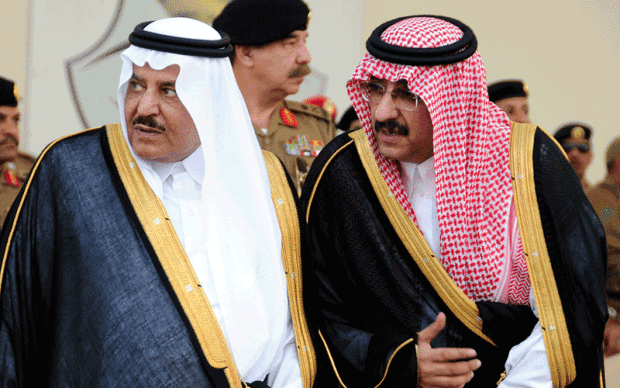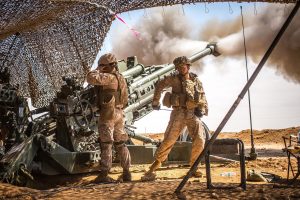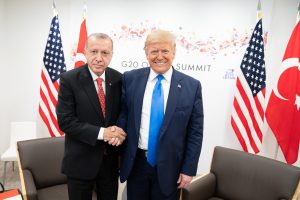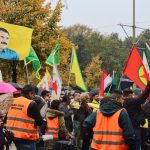by Thomas Lippman
For the United States, Saudi Arabia, other supporters of the rebels in Syria, and for the rebels themselves, this has been a month of fast-paced, intense diplomatic and political activity. It is tempting after so much time and so many deaths to dismiss all the events since mid-January as the inconclusive comings and goings of people who simply don’t know what to do about the intractable conflict, but it’s also possible to add it all up and see the possibility of an emerging new energy, cohesion, and perhaps more effective action.
At the very least, the events and consultations since mid-January seem to have put the United States and Saudi Arabia back on the same page.
A useful point to begin this review is the visit to Washington in mid-January of Prince Muhammad bin Nayef, Saudi Arabia’s minister of interior and the most powerful man in the country other than the king. Nayef, who is respected in Washington for his leadership of Saudi Arabia’s struggle against an al-Qaeda uprising a decade ago, saw everyone in the U.S. national security establishment, plus key members of Congress. Not much was said publicly about the outcome, but within a couple of weeks events began to unfold rapidly.
On Feb. 3, a few days before Prince Muhammad left for Washington, King Abdullah of Saudi Arabia issued a royal decree making it a crime, punishable by prison time, for any Saudi citizen to fight in a foreign conflict. This reflected Riyadh’s concern about the hundreds of young Saudis who have joined extremist rebel groups in Syria and could some day return to make trouble at home. It also was aimed at deflecting criticism from Washington, where some officials have said Riyadh was not doing enough to cut off the flow of fighters.
That same day, Feb. 3, the White House confirmed reports that Obama will visit Saudi Arabia in late March. This has been a difficult year for U.S.-Saudi relations due to disagreements over Iran’s nuclear program and policy toward Egypt, as well as over Syria. Obama’s planned visit is clearly intended to smooth over some of these differences; the conversations would have been more difficult still if the issue of Saudis going to Syria to fight with the jihadi extremists were still on the table.
On Feb. 12, according to the Saudi embassy, Prince Muhammad met with Deputy Secretary of State William Burns and with Under Secretary Wendy Sherman. She holds the administration’s Iran nuclear portfolio and has strongly defended its interim agreement with Tehran, a deal that caused heartburn in Riyadh. While in Washington, Muhammad also met with CIA officials and with the intelligence chiefs of Turkey, Qatar, Jordan and other supporters of the rebels, according to press reports.
Then the pace of events accelerated.
On Feb. 12, King Abdullah II of Jordan, whose country is straining under the burden of supporting Syrian refugees, met with Vice President Joe Biden to discuss “ongoing efforts to bring about a political transition and an end to the conflict in Syria,” the White House said. Two days later, Abdullah conferred with Obama.
On Feb. 15, the UN-brokered peace talks in Geneva ended, predictably, in failure. Secretary of State John Kerry put the blame squarely on the Assad regime’s intransigence, but regardless of who was responsible, that avenue now appears to have come to a dead end.
The next day, the Supreme Military Council of the Free Syrian Army — that is, the non-extremist rebels whom Washington and presumably Riyadh support — announced that Gen. Salam Idriss, the overall military commander who had been increasingly criticized as ineffective, was being replaced. His successor, backed by the Saudis, is Brig. Gen. Abdul-Illah Bashir al-Noeimi. It is too early to know whether he will be able to enlist the support of all the often-divided rebel factions, who are battling extremist forces aligned with al-Qaeda as well as the Syrian army.
Back in Washington, the White House announced on Feb. 18 that Robert Malley, a veteran Middle East hand from the Clinton administration, would return to the National Security Council. His assignment is to manage relations with the often-fractious allies of the Arab Gulf states, a group that includes Saudi Arabia.
A day later, Feb. 19, the Washington Post and the Wall Street Journal broke the news that Prince Muhammad bin Nayef had taken over as boss of the kingdom’s effort to arm and strengthen the Free Syrian Army and other non-extremist groups. The Post’s Karen de Young reported the next day that the intelligence chiefs, at their Washington gathering a week earlier, had agreed on how to define which rebel groups were eligible for new aid, and on new arms shipments to them. Muhammad, a firm if low-key operative, replaced the mercurial Prince Bandar bin Sultan, whose personal charisma had evidently not impressed the rebels.
That same day, Feb. 19, Deputy Secretary Burns delivered a speech that was widely depicted as a preview of what Obama will say to King Abdullah next month: the United States is committed to its strategic partnership with the Arab Gulf states, and will not be bamboozled into a permanent agreement with Iran that would leave Tehran with any path to nuclear weapons. Telling the Saudis what they want to hear, Burns said that in Syria, “the simple truth is that there can be no stability and no resolution to the crisis without a transition to a new leadership.” That is, Bashar al-Assad must go, as the Saudis and Obama himself have long demanded, and Riyadh should not interpret the agreement by which Syria is due to give up its chemical weapons as U.S. acquiescence in Assad’s legitimacy.
Meanwhile, of course, Syrians are dying by the thousands as the government continues to bomb civilian areas, and there is no end in sight. Even if Assad steps down, Burns said, the United States has “no illusions” about “the very difficult day after — or, more likely, the very difficult years after.”
Russia, Iran, and Hezbollah are still supporting Assad. It is possible that he could survive to preside over some rump state. But it does appear that the working program of those who want to get rid of him is, at least, less messy and disorganized than it was a month ago.
*This post was revised on Feb. 25 to make an adjustment to the sequence of events.
Photo: Saudi Interior Minister Prince Nayef bin Abdul Aziz al-Saud (left) with Prince Mohammed bin Nayef bin Abdul Azi






The biter is now worried about getting bit, eh? The one good item in this report is the fact that bin Sultan has been booted out. It should have been blindingly obvious long ago that he was sowing the seeds for real trouble in future, just like Reagan did when he armed Afghan mujaheddin against the Soviets in the 1980s, setting in place the emergence of the Pakistan-backed Taliban and Al Qaeda.
There is no good reason why the US should be involved at all in the Middle East or South West Asia any more, particularly as Obama has brought the US to the point of complete energy independence.
Leave the Syrians alone to find their own future and tell Israel to stop interfering in the area.
Tell Israel also that they will get no more assistance from the US until such time as they achieve reconciliation with the Palestinians.
Resolve that problem and many of the other area-related problems will resolve themselves real quick.
I’m sure included in this recent flurry of conversations between between Washington and Saudi Arabia were warnings not to mess with the Sochi Olympics. The connections between the Saudis and the Islamic militants in central Russia are well established. You can bet the Saudis were telling the jihadists the prospect of American athletes and spectators being mangled in suicide bombings was not going to be tolerated by the empire.
Bear in mind that when bin Sultan visited Putin before the games he allegedly threatened that he would unleash jihadist attacks against the games. This may also have some bearing on bin Sultan’s downfall.
My guess is that not even the Sauds would dare trying to take on Putin and Russia. They have been powerless to stop Russia supporting Syria and – indirectly – Iran. Reports today are that Iraq is now buying weapons systems from Iran – not the USA. What does that say for the US intervention in Iraq?
What ever solution finally emerges pertaining to Syria should take into account that as a group the Shia, Christian, Druze and Kurds constitute a large minority that are not inline necessarily with what Saudi Arabia (Wahhabi)-US axis may want installed in Damascus. Should the eventual resolution omit such realities on the ground and a Wahhabi/Saudi leaning regime come to power, one may see many years of conflict ahead of the region.